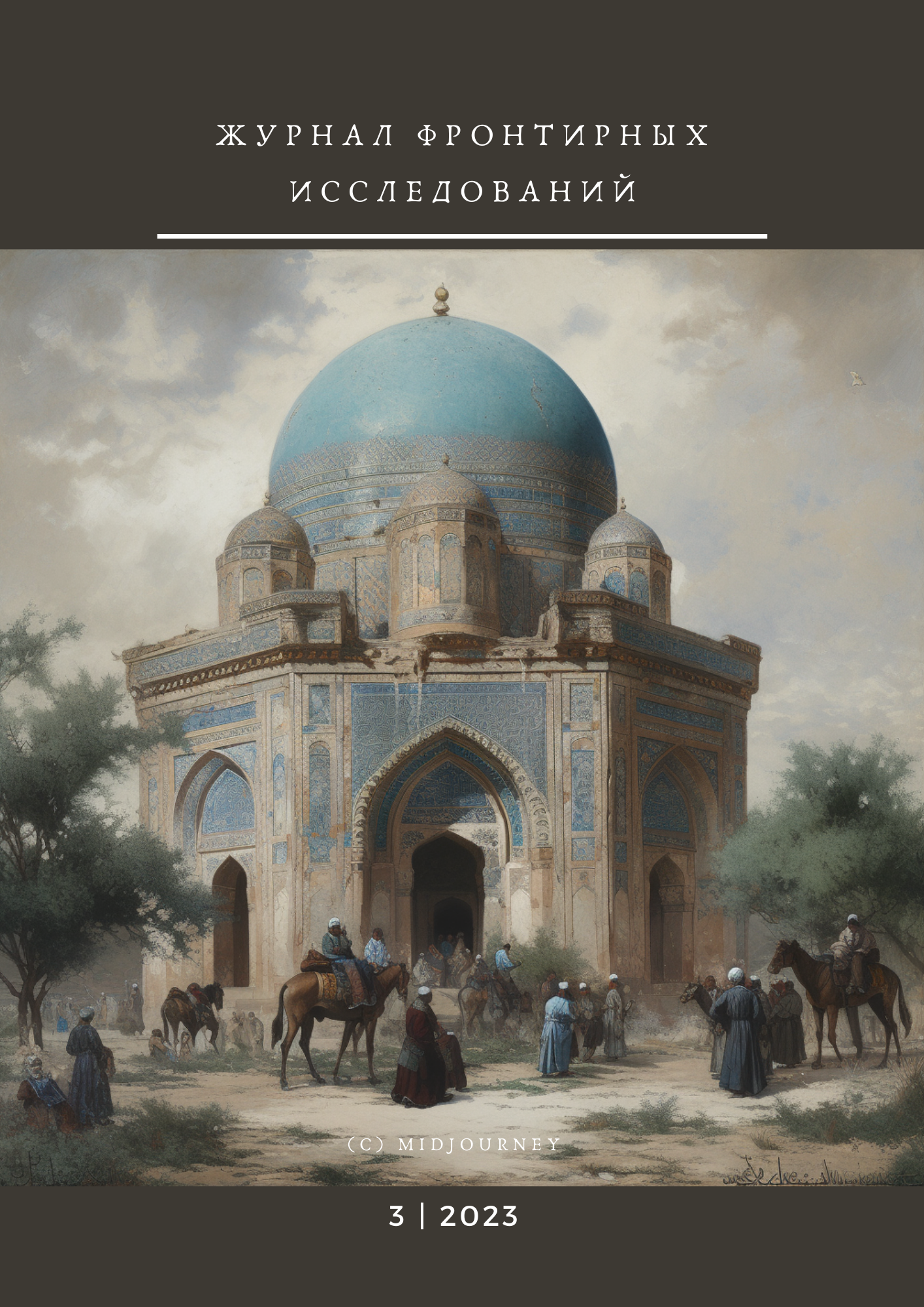Abstract
This article delves into the history of a group of Mennonites who migrated from Russia to Turkestan in the late 1870s. Utilizing a wide range of archival sources, publications, and oral history, the author analyzes the reasons for the Mennonites’ migration, their adaptation to new conditions drastically different from their previous locales. Special attention is given to the relationship between Mennonites and local residents on cultural and socio-economic levels.
Considering public administration within the Mennonite community, the author stresses the vital role played by the elected headman, or “forshteer”, who represented the administrative authority and maintained order in the settlement. The successful evolution of the Mennonite community hinged on his adept administration. Interestingly, this form of public administration bears similarities to the self-governing authorities of the “Mahalla” community, a system long-standing in Central Asia.
In conclusion, the author surmises that despite not knowing the language, customs, or culture of the local peoples, with the support of the Khan and Khiva neighbors, the Akmechet Mennonite diaspora managed to settle quite well, leaving a positive imprint in the region.
The experience of tolerant relationships among the peoples of Uzbekistan towards migrants, which resulted in cordial neighborly relations, can still be useful today, in this challenging global climate.
References
Belk, F. R. (2001). The great trek of the Russian Mennonites to Central Asia, 1880-1884. Wipf and Stock Publishers.
Dzhumaniyazova, M. T., & Zaripbaeva, Z. Z. (2021). Population of the Khivа Khanate in the XVIII-XIX centuries. Tsifrovaya nauka, 3, 142–148. (In Russian).
Fitts, A. (1992). Zabytye fragmenty istorii. Vera v zhizn', 3. (In Russian).
Gejer, I. (1892). Krest'janskaja kolonizacija v Syr-Dar'inskoj oblasti. In I. Gejer (Ed.), Sbornik materialov dlja statistiki Syr-Dar'inskoj oblasti (pp. 201–320). б. и. (In Russian).
Gentshke, V. L. (2007). Mennonity v Turkestane: Konets XIX – nachalo XX veka (po materialam Tsentral'nogo gosudarstvennogo arkhiva Respubliki Uzbekistan). Rossiyskoe gosudarstvo, obshchestvo i etnicheskie nemtsy: osnovnye etapy i kharakter vazimootnosheniy (XVIII-XXI vv.). Materialy XI mezhdunarodnoy nauchnoy konferentsii, 168–175. (In Russian).
Inoyatova, D. M. (2008). One Example of the Migratory Processes of Evropeans in Central Asia: The Germans of Uzbekistan. In H. Rittersberger-Tılıç (Ed.), Rethinking global migration: Practices, policies and discourses in the European neighbourhood. Zeplin lİetişim Hizmetleri Ltd. Şti.
Inoyatova, D. M. (2016). Mennonites in Central Asia: Investment into Modernization of Economics and Culture. In Marginal or Mainstream? Anabaptists, Mennonites and Modernity in European Society (pp. 161–177). Bethel College.
Inoyatova, D. M. (2019a). Nemetskaya diaspora Uzbekistana: Vekhi istorii. Turon-Iqbol. (In Russian).
Inoyatova, D. M. (2019b). Vekovye traditsii druzhby i tolerantnosti uzbekskogo i nemetskogo narodov. Uzbekiston. (In Russian).
Istoriya Uzbekistana. (2011). n. p. (In Russian).
Kalandarov, K. (2010). Interv'yu s eks direktorom shkoly Chikirchi Yangi-Arykskogo rayona Khorezmskoy oblasti. n. p. (In Russian).
Knauer, N. Kh. (2002). Nemtsy. In Etnicheskiy Atlas Uzbekistana (pp. 166–170). Uzbekistan. (In Russian).
Kriger, V. (2006). Reyn-Volga-Irtysh: Iz istorii nemtsev Tsentral'noy Azii. Dayk-Press. (In Russian).
Krongardt, G. K. (1997). Nemtsy v Kyrgyzstane 1880-1990 gg. Ilim. (In Russian).
Lykoshin, N. S. (1917). Nemtsy v Khive. Turkestanskoe slovo, 34. (In Russian).
Marginal or Mainstream? Anabaptists, Mennonites and Modernity in European Society. (2016). Bethel College.
Matveev, A. M. (1970). K voprosu o vykhodtsakh iz Germanii v Sredney Azii v kontse XIX – nachale XX veka. Nauchnye trudy TashGU, 392. (In Russian).
National Archives of Uzbekistan. (1871-1918). Ф. I-17. In. 1. C. 32816. (In Russian).
National Archives of Uzbekistan. (1897a). F. I-1. In. 11. C. 1479. (In Russian).
National Archives of Uzbekistan. (1897b). F. I-1. In. 16. C. 2385. (In Russian).
National Archives of Uzbekistan. (1912). Ф. I-2. In. 1. C. 314. (In Russian).
National Archives of Uzbekistan. (1988). Ф. R-2813. In. 1. C. 5. (In Russian).
National Archives of Uzbekistan. (n. d.-a). F. I-1. In. 29. C. 537. L. 1. (In Russian).
National Archives of Uzbekistan. (n. d.-b). F. I-1. Оп.1. C. 1987. L. 2. (In Russian).
National Archives of Uzbekistan. (n. d.-c). F. I-36. Оп.1 C. 1778. L. 1-9. (In Russian).
Ratliff, W. (2016). Mennonites in Khiva: A Modernizing Community. In Marginal or Mainstream? Anabaptists, Mennonites and Modernity in European Society (pp. 179–193). Bethel College.
Ratliff, W. R. (2010). Pilgrims on the Silk Road: A Muslim-Christian encounter in Khiva. Wipf & Stock.
Salaeva, A., & Kadyrov, A. (2021). Interv'yu s zhitelyami Chikirchi Yangi-Arykskogo rayona Khorezmskoy oblasti. n. p. (In Russian).
Sariev, K. (2007). Interv'yu s direktorom shkoly Chikirchi Yangi-Arykskogo rayona. n. p. (In Russian).
State Archive of Khorezm Province (SAKP). (1934). F. 69. In. 1. C. 546. (In Russian).
Troynitskiy, N. A. (Ed.). (1905). Pervaya vseobshchaya perepis' naseleniya 1897 g. Izdatel'stvo Tsentral'nogo Statisticheskogo komiteta Ministerstva vneshnikh del. (In Russian).
Zhukova, L. I. (2002). Mennonity v Khorezme. In Etnicheskiy Atlas Uzbekistana (pp. 173–175). Uzbekistan. (In Russian).

This work is licensed under a Creative Commons Attribution 4.0 International License.


